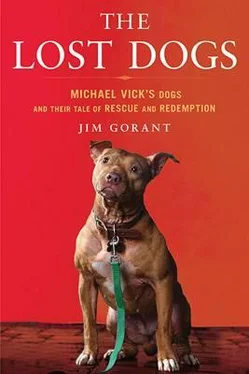It was in many ways a stunning moment. It had been less than four months since the initial raid at 1915 Moonlight Road and less than three months since the federal government moved to act on the case. The two lead investigators had overcome indifference or outright hostility from their managers, the U.S. attorney had agreed to take on a case that many others might have deemed too messy and uncertain, and for possibly the first time in a legal setting, dogs were viewed not as the implements of a harsh and brutal undertaking but as the victims of it.
Now, if only a few of them could be spared.

September 1, 2007, to December 25, 2007
DONNA REY NOLDS AND TIM Racer had never been so happy to end a vacation early. It was September 2, the Sunday of Labor Day weekend and just days after Michael Vick’s plea hearing, when Reynolds and Racer packed up their stuff and walked out of the house they’d rented in Stinson Beach, California. They would have loved to stay, but they were off to bigger things.
The next day they caught a flight to Richmond, where they would gather with seven other canine experts brought together to evaluate the Vick dogs. Six of the nine people on the panel worked for the ASPCA, and those who weren’t Ph.D.s were at the very least certified animal behaviorists. Reynolds and Racer came from a different place altogether.
They were artists by trade, and they dressed the part. Racer, thin and athletic, tended toward cargo shorts with work boots and loose T-shirts. With brown hair and a broad face centered by a flat nose, Racer spoke directly with plenty of eye contact and so fast that “pit bull” became not two distinct words but one hybrid: “pitble.” Reynolds, by contrast, faced the world with a high wall of curly hair, full cheeks, and a big smile, but always seemed to be saying less than she was thinking, a sensation heightened by her arching eyebrows and deep, wary eyes. She accented her outfits with funky add-ons: a necklace made of red dice, laceless Chuck Taylors, or black military-looking boots.
Michigan natives, the pair met in 1980, during their first week of classes at the College for Creative Studies in Detroit. Upon graduation they moved to Chicago where they rented a small studio. Racer, a wood carver, began working on carousel-style animals, posed figures done in the seamless, high-gloss style of merry-go-round horses. Reynolds made her career as a found-art illustrator, creating collages and pictures out of existing materials, which she sold to magazines.
They began rescuing dogs off the streets-bringing home strays, training them and then finding them homes. Over four years they established themselves as working artists, took in and found homes for dozens of dogs, and enjoyed the benefits of big-city life. But they grew weary of the cold weather, so in 1991 they packed up and headed for Berkeley, figuring the funky college town with a large arts community would be perfect for them. It was not. Somehow, they never felt comfortable there and migrated toward Oakland, which fit better. It was grittier and simpler, more diverse. It was like Detroit, but nicer.
Their self-employed status allowed them to set their own schedule-i. e., go in late and stay late-and they began using part of their days to work with a raptor rescue program at the Lindsay Wildlife Museum in Walnut Creek, California. There they helped injured or lost owls, hawks, eagles, and falcons relearn how to fly or walk or hunt.
They continued to take in dogs, too, and in 1995 they got a call from a woman who knew they helped strays. She had been driving her car along the highway one night when she saw an injured dog on the side of the road. She pulled over and realized it was in even worse shape than she suspected. The animal clearly needed more help than she could give it and she wasn’t sure what to do. After a moment of thought she swung open the back door and said, “If it gets in the car, I’ll help it. If not…” The dog crawled into the backseat and collapsed.
She took it to a shelter and implored Reynolds and Racer to go get it. When they went to see it, they cringed as the shelter workers brought out a small male pit bull, maybe thirty-five pounds, black and covered with cuts and scars. Tubes and wires ran from the dog’s body and wherever it went someone had to walk behind it, rolling the IV stand that it was hooked up to. “It looks like someone wrapped him in barbed wire and rolled him down a hill,” Reynolds said.
On one side, the dog’s lip was just sort of hanging off. “His face is like hamburger,” added Racer. And yet, upon walking in, the dog seemed to smile at them. It went up to Racer and began rubbing against his legs.
“Race, we’re in trouble here,” Reynolds said. The couple took the dog in. They called him Mr. B, and they worked hard to nurse him back to health. Reynolds hit the Internet. On one pit bull message board she encountered a character called Old Dog. On the board he had always come off as a bit of an asshole the way Reynolds saw it. But he knew his stuff and when Reynolds described her situation, he offered to help.
Reynolds was willing to take assistance from whoever would give it because there was more at stake than simply the survival of the dog. The woman who had picked him up off the road was in the midst of a battle against cancer, and she was coming to see the dog’s survival as a metaphor for her own struggle. It became very important to her that the dog make it, and she took a keen interest in his progress.
Eventually, Reynolds took Mr. B to see Old Dog, who turned out to be a legitimate dog breeder and a bit of a cowboy from central California. Old Dog agreed to take Mr. B in and give him a foster home until the dog could be adopted. Before long he’d adopted Mr. B himself, but even more important, he became a trusted resource.
Reynolds and Racer needed all the friends they could get, because the following year, 1996, they bought their first house. It became much easier for them to take in foster dogs until they could find a permanent keeper. Their experience with Mr. B had given them a taste of how desperate things were for pit bulls, which made up the majority of the shelter population nationally as well as in the Bay Area.
Through the years they had rescued whatever dogs they had stumbled upon, but now Racer proposed that they actually begin going to shelters to seek out adoption-worthy pit bulls. Reynolds had misgivings, but she agreed to take a look. At the first shelter they went to they found a beautiful brown and white pit bull. They were sure they could help her, so they brought her home and called her Sallie. She was an incredible dog-even-tempered, loving, and totally friendly with the other two dogs the couple already had.
Most people have been led to believe that pit bulls are mindless attack machines, and while they can have an inclination to be aggressive toward other dogs, the reality is that free of negative influences, they’re not much different from any other breed. Reynolds and Racer had come to see that, but that knowledge didn’t help them solve the problem they now faced: They could not find a home for Sallie. It was then that Reynolds and Racer realized how off-base and yet deeply ingrained the public perception of pit bulls remained. Racer and Reynolds suddenly understood why there were so many pit bulls languishing in shelters.
Before long they were part of a small community in the Bay Area dedicated to rescuing pit bulls. One night while a bunch of them were out together, they decided to start a Web site that would display available dogs and try to help change the pit bull’s image. So on April Fool’s Day 1999-“under the influence of many margaritas,” as Reynolds says-they formed a rescue group called Bay Area Doglovers Responsible About Pitbulls or BAD RAP.
Читать дальше













